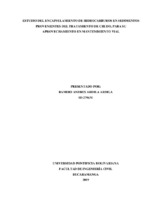| dc.contributor.advisor | Pineda Vargas, Sergio Manuel | |
| dc.contributor.author | Ardila Ardila, Ramiro Andrés | |
| dc.coverage.temporal | 2019 | |
| dc.date.accessioned | 2021-05-10T16:29:58Z | |
| dc.date.available | 2021-05-10T16:29:58Z | |
| dc.date.issued | 2019 | |
| dc.identifier.uri | http://hdl.handle.net/20.500.11912/8470 | |
| dc.description | 112 páginas | spa |
| dc.description.abstract | Este trabajo planteó alternativas físicas para el tratamiento y mejoramiento de las vías veredales del departamento de Santander mediante un proceso de encapsulamiento de un suelo de la Universidad Pontificia Bolivariana que controle la lixiviación, con el fin de ser mezclados con materiales contaminantes a los que no se les da un uso adecuado. Inicialmente se realizó la caracterización de tres tipos de suelos presentes en los predios de la UPB obteniendo características totalmente diferentes a pesar de su cercanía entre ellos. El suelo que se decidió estudiar se asemeja a las características de la mayoría de los suelos del departamento, recibiendo el nombre de limo arenoso de baja plasticidad según los ensayos realizados a la muestra. Con el fin de evitar asentamientos producto del peso de los vehículos que transitan por las vías terciarias y tener una compactación adecuada en la estructura que soporta las cargas, se investigó mediante ensayo de Proctor modificado que el suelo analizado presenta una densidad seca de 1,91 g/cm3 y un contenido de humedad de 13,3% y posteriormente realizar un ensayo de CBR donde se da una clasificación al suelo de Bueno y un uso variado para realizar una sub base y/o base en el mejoramiento y/o construcción de vías veredales. Se realizó un modelo experimental de conductividad hidráulica con cabeza variable que permita medir la permeabilidad de la mezcla de suelo con diferentes porcentajes de contaminantes (2%,4%,6%,8%) como lo es el aceite hidráulico, aceite quemado y petróleo, ya que si no se les realiza un tratamiento adecuado el suelo puede sufrir grandes problemas de tipo ambiental. Posteriormente se realiza un ensayo de lixiviación que permita observar la separación tanto de las grasas como del suelo para determinar si este puede ser utilizado en el tratamiento de las vías veredales. | spa |
| dc.description.abstract | This work proposed physical alternatives for the treatment and improvement of the roads in the department of Santander through a process of encapsulation of a land of the Pontifical Bolivarian University that controls leaching, in order to be mixed with contaminant materials that are not It gives them proper use. Initially, the characterization of three types of soils present in the UPB premises was carried out, obtaining totally different characteristics despite their proximity to each other. The soil that was decided to study resembles the characteristics of the majority of the floors of the department, receiving the name of sandy silt of low plasticity according to the tests carried out on the sample. In order to avoid settlements resulting from the weight of vehicles traveling through tertiary roads and have adequate compaction in the structure that supports the loads, it was investigated by means of a modified proctor test that the analyzed soil has a dry density of 1.91 g / cm3 and a moisture content of 13.3% and subsequently perform a CBR test where a classification is given to the soil of Bueno and a varied use to perform a sub base and / or base in the improvement and / or construction of sidewalks. An experimental model of hydraulic conductivity with variable head was made that allows measuring the permeability of the soil mixture with different percentages of pollutants (2%, 4%, 6%, 8%) such as hydraulic oil, burned oil and oil , since if they are not properly treated, the soil can suffer major environmental problems. Subsequently, a leaching test is carried out that allows observing the separation of both fats and soil to determine if this can be used in the treatment of the veredal pathways. | eng |
| dc.format.mimetype | application/pdf | |
| dc.language.iso | spa | |
| dc.publisher | Universidad Pontificia Bolivariana | spa |
| dc.rights | Attribution-NonCommercial-NoDerivatives 4.0 International | * |
| dc.rights.uri | http://creativecommons.org/licenses/by-nc-nd/4.0/ | * |
| dc.subject | Hidrocarburos | spa |
| dc.subject | Carreteras - Mantenimiento y reparación | spa |
| dc.subject | Santander (Departamento : Colombia) | spa |
| dc.subject | Veredas | spa |
| dc.subject | Suelos mezclados | spa |
| dc.subject | Lixiviación | spa |
| dc.title | Estudio del encapsulamiento de hidrocarburos en sedimentos provenientes del tratamiento de crudo, para su aprovechamiento en mantenimiento vial | spa |
| dc.type | Trabajo de grado | spa |
| dc.publisher.department | Escuela de Ingenierías | spa |
| dc.publisher.program | Ingeniería Civil | spa |
| dc.type.hasVersion | publishedVersion | spa |
| dc.description.sectional | Bucaramanga | spa |
| dc.description.degreename | Ingeniero Civil | spa |


